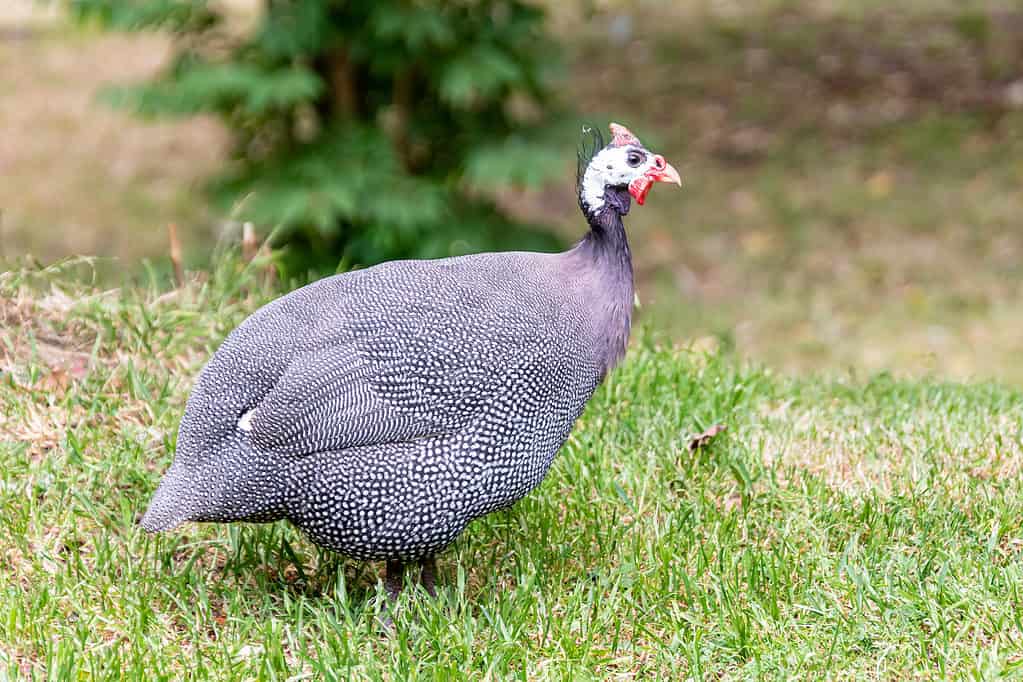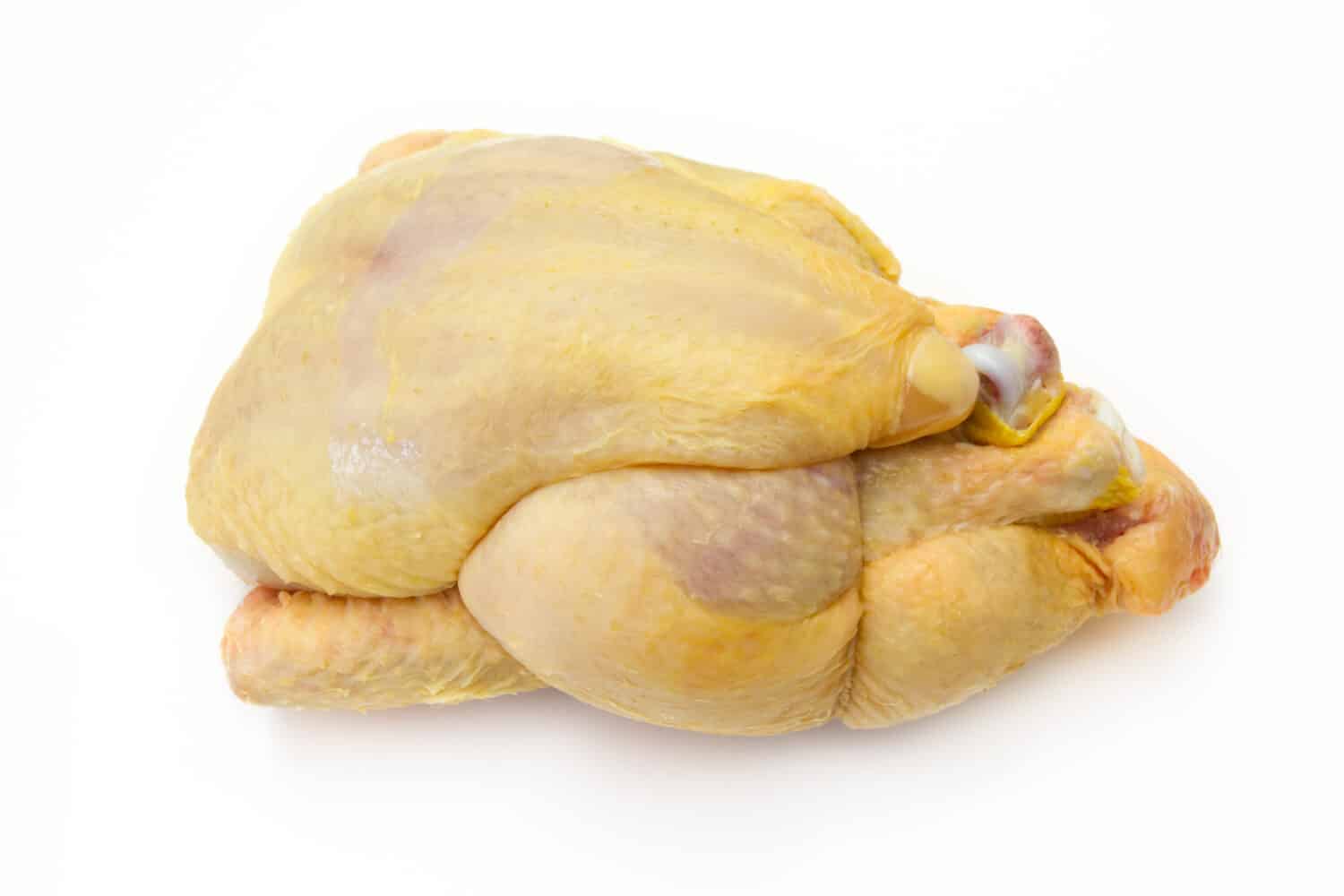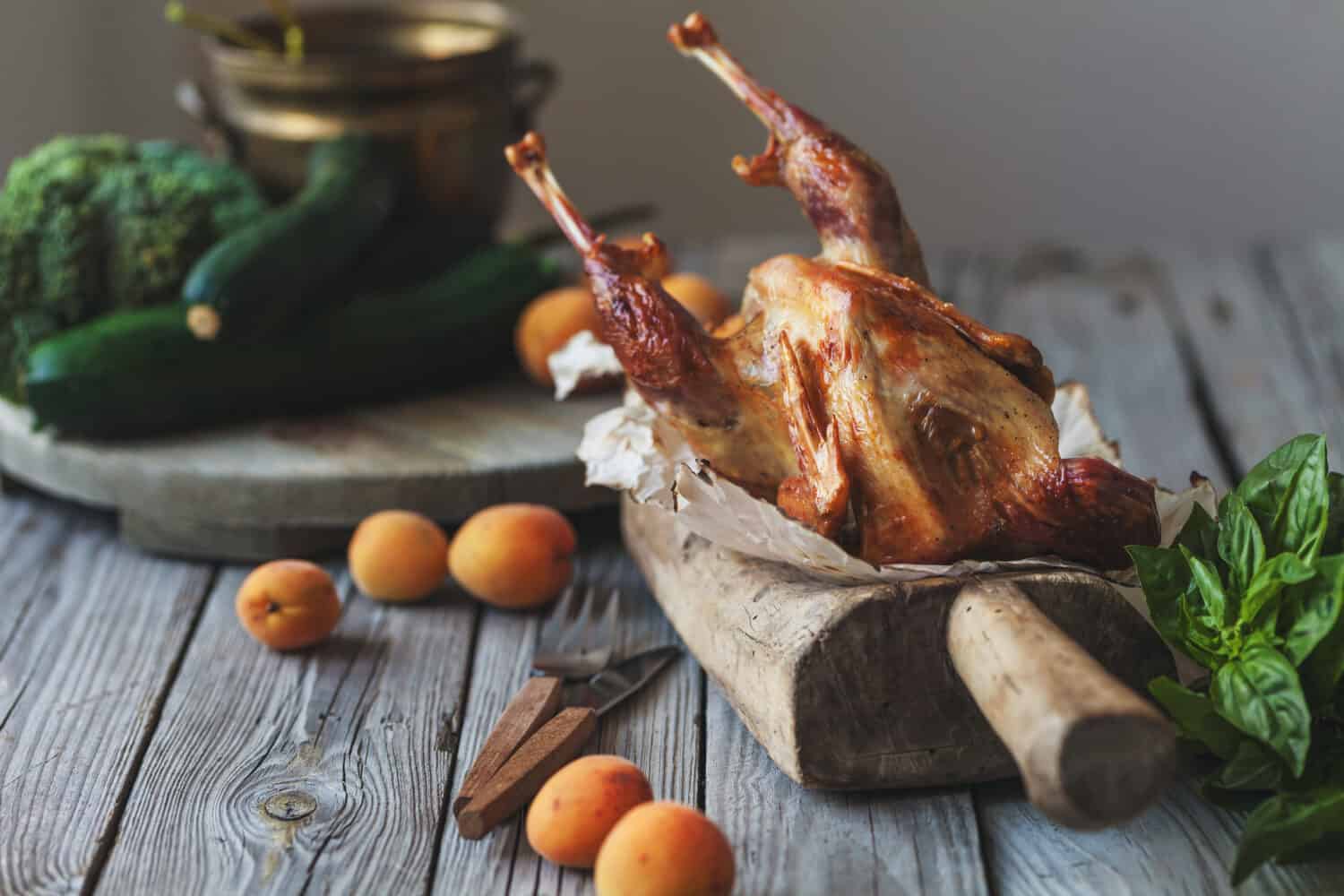Guinea fowl meat may not be on your typical menu (in the United States). However, this meat can be very tasty and nutritious. Further, it’s rich in protein and low in fat. In fact, it has three times less fat than beef.
It tastes similar to turkey or pheasant, which the guinea fowl is similar to. You can prepare it in many of the same ways, too, including roasting, frying, and stewing.
For even more benefits of this unusual meat, keep reading.
1. High in Protein

Guinea fowl meat contains a lot of protein.
©Merrillie Redden/Shutterstock.com
First, guinea fowl meat is high in protein, a vital part of a human’s diet. Protein is utilized to strengthen and maintain muscles. It’s essential for many parts of your body, including your immune system and hormone production.
According to one source, guinea fowl meat has about 28% protein, which is higher than chicken meat (which is only 23% protein). Therefore, guinea fowl provides more protein and amino acids than chicken meat, making it healthier, as well.
Consuming guinea fowl meat can help you meet your daily protein needs, which is often harder than many people realize. Your age and activity level affect how much protein you need. Therefore, if you are very active, you may benefit most from adding this protein-rich meat to your diet.
Generally, guinea fowl is a better source of protein than many other types of meat.
2. Low in Fat and Cholesterol

Guinea fowl meat contains little cholesterol, which may help prevent heart problems.
©iStock.com/Prostock-Studio
Guinea fowl is a lean protein, meaning it is low in fat and cholesterol. While these substances are important for your body, the modern American diet is often too high in them. As a result, a high-fat diet can cause cardiovascular disease.
According to some sources, guinea fowl meat has about 3% fat, which is lower than chicken meat, which has about 11% fat. Therefore, guinea fowl meat is much leaner.
With that said, guinea fowl meat does still contain some beneficial fats, like omega fatty acids. These can lower inflammation, improve blood flow, and prevent blood clots. A 100 g serving of guinea fowl meat can provide about 0.2 g of omega-3 fatty acids, about 10% of the recommended daily intake for adults.
3. It’s Tasty

Guinea fowl meat is known for being tasty and similar to turkey.
©page frederique/Shutterstock.com
Simply put, many people like the taste of guinea fowl meat. It’s very rich and lean, similar to turkey. However, the texture is not as dry, and the meat is darker. It has a slightly gamey flavor, though this isn’t overpowering.
You can prepare it in many ways you would chicken or turkey. Therefore, you don’t need to completely reimagine your meals to eat it. Some of the common seasonings for guinea fowl meat are garlic, rosemary, thyme, sage, lemon, mustard, honey, and wine. It pairs nicely with the same things turkey does, as well.
4. Good Source of Vitamins & Minerals

Guinea fowl meat contains tons of different vitamins and minerals.
©fizkes/Shutterstock.com
Guinea fowl meat includes many different vitamins and minerals, helping ensure you’re eating everything you need. Everyone needs vitamins and minerals to survive, as they are responsible for most of our bodily functions.
For instance, here are estimated amounts of vitamins and minerals in 100 g of guinea fowl meat:
- Calcium: 13 mg (1% of DV). Calcium is important for bone health, muscle contraction, nerve transmission, and blood clotting.
- Iron: 2.8 mg (16% of the DV). Iron is important for blood formation, oxygen transport, and enzyme activity.
- Magnesium: 23 mg (6% of the DV). Magnesium regulates muscle and nerve function, energy production, and blood pressure.
- Phosphorus: 226 mg (23% of the DV). Phosphorus is important for bone and teeth formation, energy metabolism, and acid-base balance.
- Potassium: 383 mg (8% of the DV). Potassium is important for fluid and electrolyte balance, nerve and muscle function, and blood pressure regulation.
- Sodium: 64 mg (3% of the DV). Sodium is important for fluid and electrolyte balance, nerve and muscle function, and blood pressure regulation.
- Zinc: 2.4 mg (16% of the DV). Zinc is important for immune function, wound healing, growth, and development.
- Vitamin A: 12 mcg (1% of the DV). Vitamin A is important for vision, skin health, immunity, and reproduction.
- Vitamin B1 (thiamine): 0.1 mg (7% of the DV). Vitamin B1 is important for energy metabolism, nerve function, and carbohydrate utilization.
- Vitamin B2 (riboflavin): 0.2 mg (12% of the DV). Vitamin B2 is important for energy metabolism, antioxidant protection, and tissue maintenance.
- Vitamin B3 (niacin): 9.5 mg (48% of the DV). Vitamin B3 is important for energy metabolism, DNA synthesis, and cholesterol regulation.
- Vitamin B5 (pantothenic acid): 1.3 mg (13% of the DV). Vitamin B5 is important for energy metabolism, hormone synthesis, and fatty acid oxidation.
- Vitamin B6 (pyridoxine): 0.5 mg (25% of the DV). Vitamin B6 is important for amino acid metabolism, neurotransmitter synthesis, and hemoglobin formation.
- Vitamin B9 (folate): 5 mcg (1% of the DV). Vitamin B9 is important for DNA synthesis, cell division, and neural tube development.
- Vitamin B12 (cobalamin): 0.4 mcg (17% of the DV). Vitamin B12 is important for DNA synthesis, nerve function, and red blood cell formation.
5. It’s a Delicacy

As it’s a delicacy, guinea fowl meat is served at many high-end restaurants and hotels.
©Mateusz Gzik/Shutterstock.com
Guinea Fowl meat is considered a delicacy. It’s a popular meat in gourmet and exotic restaurants and hotels, as it’s a tasty meat that’s hard to find.
For instance, guinea fowl meat is not widely available in supermarkets. Therefore, it can be a special treat for your family and friends on special occasions. You can purchase guinea fowl meat online from many suppliers or even raise your own birds.
6. Easy to Cook

In any case, guinea fowl meat can be utilized in
manydifferent recipes.
©Piotr Krzeslak/Shutterstock.com
Equally important, you don’t have to learn anything fancy to cook guinea fowl meat. For the most part, you can cook it just like any other type of bird. It doesn’t require much seasoning or marinating, as it is very tasty by itself.
For example, you can prepare it by roasting, grilling, frying, or stewing, depending on your preferences. While using recipes can help make the dish more interesting, you shouldn’t need to do anything complicated.
7. Versatile

Guinea fowl doesn’t require any fancy techniques to cook. Therefore, you can use it in your meals easily.
©SunKids/Shutterstock.com
Unlike some other meats, you can use guinea fowl meat for a variety of purposes. It’s great in soups. Further, you can even use the bones and carcasses to make a flavorful stock. The meat also works great in salads, similar to chicken. Additionally, you can use the breast or leg meat of the bird and cook it with some oil, salt, pepper, and herbs before adding it to the top of your salad.
You’ll also find recipes that call for guinea fowl in casseroles, sandwiches, and wraps. Just like chicken, it is a very versatile meat that works surprisingly well in many situations.
8. Economical

Guinea fowl is a great way to feed a gathering of people.
©Drazen Zigic/Shutterstock.com
Guinea fowls are somewhat larger than chickens (usually). Therefore, it’s often a more efficient choice when feeding many people. Plus, it’s also cheaper than most types of poultry per pound, allowing you to save significant amounts of money. In many cases, you can purchase a whole guinea fowl for about $10.
Because it is higher in protein, it’s also more filling than chicken. As a result, people often have to eat less. One guinea fowl can feed about four adults.
9. Sustainable
Additionally, guinea fowl meat is more sustainable than many types of meat, especially if the bird is allowed to roam. These birds are independent and forage for their food, so they do not require much commercial feed. Instead, they eat insects and native plants. They aren’t very picky.
Furthermore, they don’t typically require antibiotics or hormones to grow properly as other modern agricultural animals do.
Often, those who raise guinea fowl keep them free-range, as this is the most economical way to raise them. Indeed, if you want more ethical meat, then guinea fowl is a great option.
10. Easy to Raise

Guinea fowl can be a great alternative to chickens if you’re looking to raise your own birds.
©Peter Fodor/Shutterstock.com
Finally, guinea fowls are one of the easier animals to raise, meaning you can raise your own birds easier than others. They’re fun to raise and offer many benefits beyond their meat. For instance, they will lay about 100 to 120 eggs per year, which are richer than chicken eggs. They also have beautiful feathers that come in a range of different colors.
They are curious, intelligent, and social animals that can bond with you and each other. Besides, they’re typically more resistant to predators than other farm animals and decently independent.
Summary of Why You Should Try Guinea Fowl Meat
In conclusion, here’s a quick recap of everything we’ve discussed:
| Number | Guinea Fowl Meat Fact |
|---|---|
| 1 | Rich in Protein |
| 2 | Low in Fat and Cholesterol |
| 3 | Rich, Lean Taste |
| 4 | Good Source of Vitamins and Minerals |
| 5 | Delicacy |
| 6 | Easy to Cook |
| 7 | Versatile |
| 8 | Economical |
| 9 | Sustainable |
| 10 | Fun to Raise |
The photo featured at the top of this post is © tristan tan/Shutterstock.com
Thank you for reading! Have some feedback for us? Contact the AZ Animals editorial team.







